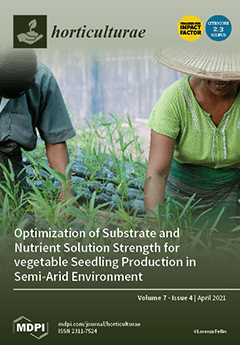Tomatoes are usually consumed daily in the human diet. High temperatures reduce the number of tomato yields per year. Heat stress has been considered one of the most prominent causes of alterations in morphological and molecular characteristics in crops that decrease normal growth, production, and yield in diverse plants, including tomatoes (
Solanum lycopersicum L.). In this study, we evaluated six tomato lines, namely G1, G2, G3, G4, G5, and G6, at morphological, molecular, and cytological levels under heat stress. The average results of two seasons (2018 and 2019) clarified that the G6, G1, and G2 lines recorded the highest flowering values, as well as some fruit and vegetative growth traits. Furthermore, G6 and G2 had the maximum number of fruits/plant, whereas G2 and G1 produced the highest yield/plant under high temperatures. The number of chromosomes in all lines was 2n = 24, except for G5, in which the number was 2n = 26, whereas chromosome sizes were small, ranging from 323.08 to 464.48 µm. The G1 cultivar was a symmetrical cultivar (primitive), having the highest total form percentage (TF%) and symmetry index (Syi) values and the minimum karyotype asymmetry index (ASK) value, whereas G4 was asymmetrical (advanced). Molecular marker analysis demonstrated that intersimple sequence repeat (ISSR) primers 49A, HB-14, 49A, 49B, and 89B presented the highest values for polymorphism percentage P%, marker index (MI), effective multiplex ratio (EMR), and polymorphism information content (PIC), respectively. In contrast, OP-A3, OP-B3, SCoT 2, and SCoT 12 primers showed the highest PIC, EMR, MI, P%, and resolving power (Rp) values across the studied random amplified polymorphic DNA (RAPD) and start codon-targeted (SCoT) primers. Moreover, ISSR revealed the highest number of unique specific markers (6), followed by RAPD (4) and SCoT (3) markers. Cluster analysis of combined cytological data and data relating to molecular marker attributes separated the G1, G2, and G3 lines into one group, whereas the other lines were clustered in another group. On the whole, the application of combined analysis using morphological, cytological, and molecular genetics techniques could be considered to provide suitable parameters for studying the evolution of the genetic divergence between the studied tomato lines.
Full article





